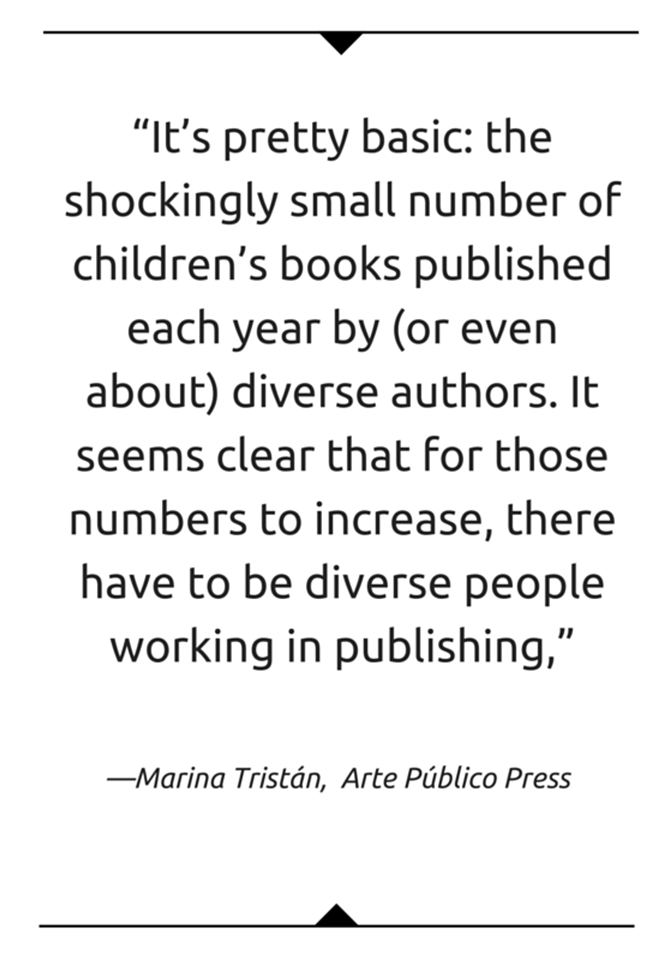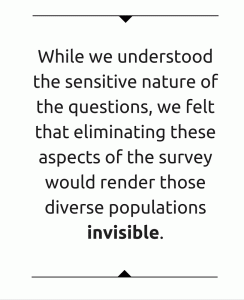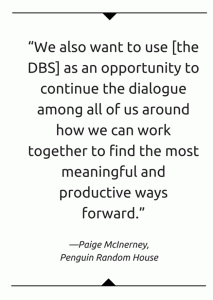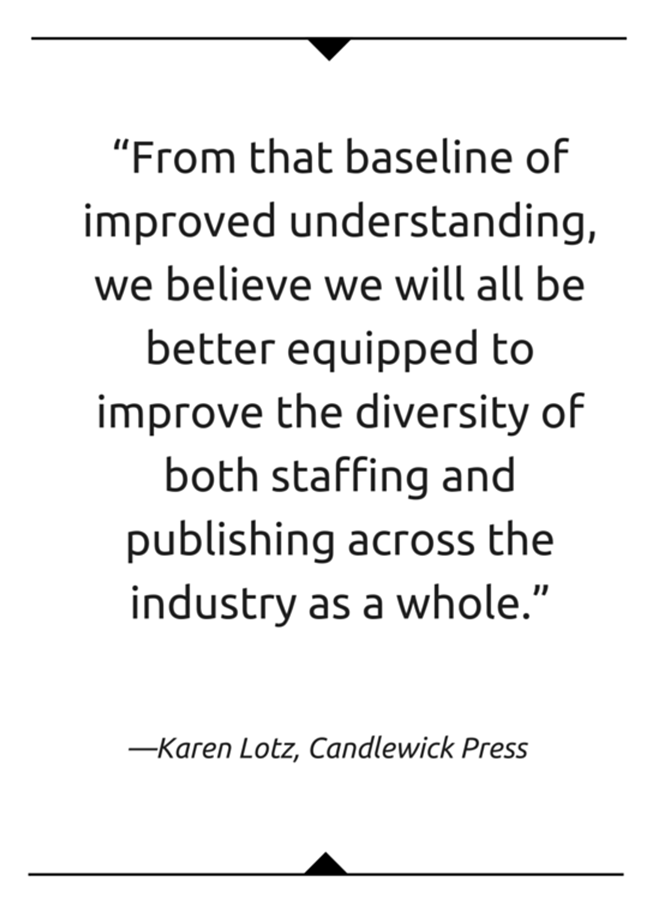 On Tuesday, January 26, 2016 we will release the results of the Diversity Baseline Survey, the first major study to look at diversity among publishing industry staff. The Diversity Baseline Survey (DBS) focuses on four different aspects of diversity: race, gender, sexual orientation, and disability. The goal is to establish a baseline that shows where we are now as an industry, and that will help us measure progress moving forward.
On Tuesday, January 26, 2016 we will release the results of the Diversity Baseline Survey, the first major study to look at diversity among publishing industry staff. The Diversity Baseline Survey (DBS) focuses on four different aspects of diversity: race, gender, sexual orientation, and disability. The goal is to establish a baseline that shows where we are now as an industry, and that will help us measure progress moving forward.
The DBS was inspired by a similar movement in the technology industry, led by Pinterest engineer Tracy Chou. Tracy pointed to tech’s lack of diversity—and lack of data—and was able to galvanize the entire industry to release staff diversity figures in 2014. We posted a study on our blog called The Diversity Gap in Silicon Valley that breaks down the problem and the responses. After the tech industry released their statistics, several new initiatives were announced to encourage recruitment and retaining of diverse new talent. We wondered, could publishing do the same?
Reviewers and Independents Lead the Charge
We began by discussing the idea of creating a baseline with people at a few major review journals. School Library Journal Editor Kiera Parrott was one of the first to say yes. “Since SLJ reviews over 6,000 materials every year, that puts us in a privileged and powerful position; our reviews help determine what books and materials librarians purchase—or not,” she said. “We are gatekeepers, of a sort. When Jason Low asked me what our reviewers looked like, in terms of their diversity, I had no idea. It was a question that had never been asked in SLJ’s more that 60-year history. Participating in the survey was the first concrete and actionable thing I could do to be part of the solution.”
at a few major review journals. School Library Journal Editor Kiera Parrott was one of the first to say yes. “Since SLJ reviews over 6,000 materials every year, that puts us in a privileged and powerful position; our reviews help determine what books and materials librarians purchase—or not,” she said. “We are gatekeepers, of a sort. When Jason Low asked me what our reviewers looked like, in terms of their diversity, I had no idea. It was a question that had never been asked in SLJ’s more that 60-year history. Participating in the survey was the first concrete and actionable thing I could do to be part of the solution.”
Most of the reviewer journals we spoke to felt the same way as School Library Journal about the survey and promised their support. Eventually we lined up eight review journals that agreed to survey their reviewers.
We then started recruiting publishers. We approached small publishers first, for the simple reason that their hierarchy is not as deep and it was easier to communicate directly with decision makers. It is also worth noting that historically, small presses have a reputation for being strong supporters of diversity long before it became trendy. The reception was enthusiastic. Charlesbridge, an independent children’s book publisher, signed on immediately. “When we decided to participate in the DBS, we hoped to look at ourselves and at what we’re doing well and where we need work, as well as to join the ranks of people standing up and saying let’s embrace change,” said Donna Spurlock, Director of Marketing at Charlesbridge.
Arte Público Press also joined early on. “It’s pretty basic: the shockingly small number of children’s books published each year by (or even about) diverse authors. It seems clear that for those numbers to increase, there have to be diverse people working in publishing,” said Marina Tristán, Assistant Director at Arte Público. “And the first step towards making change is exposing the problem.”
Roadblocks Force Change
When we started approaching mid-size publishers, progress stalled. Many publishers flat out turned us down, concerned about transparency. Originally we had asked each publisher to release their own numbers, as many tech companies had. But many publishers felt that this could reflect poorly on their companies. HR representatives were also concerned with the content of the survey itself, which asked about some very personal things, including gender identity, sexual orientation, and disability. Many state laws prevent employers from asking their employees about these matters.
transparency. Originally we had asked each publisher to release their own numbers, as many tech companies had. But many publishers felt that this could reflect poorly on their companies. HR representatives were also concerned with the content of the survey itself, which asked about some very personal things, including gender identity, sexual orientation, and disability. Many state laws prevent employers from asking their employees about these matters.
We considered setting aside gender identity, sexual orientation, and disability and focusing on race alone. But we felt that these aspects of diversity were also essential to a healthy and inclusive publishing ecosystem. While we understood the sensitive nature of the questions, eliminating these questions on the survey would render these diverse populations invisible. However, one thing became clear: if we wanted to measure these aspects of diversity, we would need to find a way to protect employee privacy and make sure that respondents’ answers remained absolutely anonymous.
We consulted with lawyers and evaluation specialists who helped us move to an aggregate model that would protect the privacy of individuals and ease the fears of Human Resources Directors. We hoped that even in aggregate form, study results would encourage a feeling of transparency and accountability in the industry. For the aggregate model to work, it was also imperative that actual data not reside with any individual publisher or reviewer. So we partnered with Dr. Sarah Park Dahlen at St. Catherine University in Minnesota, who took on the job of housing and administering the survey as well as parsing the data. Meanwhile, we solicited feedback from experts who helped us tweak the wording and format of the survey itself.
Progress was slow. As we made updates, I circled back to publishers that had initially turned us down. Gradually the list of participants grew, and as the size of participating publishers got bigger, more publishers signed on. When Chronicle Books and Candlewick joined us, we knew we had hit a turning point. Karen Lotz, President and Publisher at Candlewick, said, “We think the survey is a great step in creating a snapshot of what is currently going on within our industry, and from that baseline of improved understanding, we believe we will all be better equipped to improve the diversity of both staffing and publishing across the industry as a whole. Deciding to complete the DBS was also consistent with our longstanding commitment as a publisher to attract and retain staff whose diverse viewpoints and perspectives will improve how our company and our publishing represent, reflect, and speak to all people.”
Big Publishers Show Support
As we worked, each objection raised helped us refine the survey, reasoning, and message. Over time, the vetting process became faster and easier. There were no longer any new questions, objections, or arguments that we had not faced before. The survey picked up some momentum when Scholastic joined. It made our day when Big-Five publisher Macmillan joined us, followed by Penguin Random House. Paige McInerney, Vice President of Human Resources at Penguin Random House, said, “By participating in the DBS, we wanted to contribute to the industry’s efforts to be more transparent in this area. We also want to use it as an opportunity to continue the dialogue among all of us around how we can work together to find the most meaningful and productive ways forward.
faster and easier. There were no longer any new questions, objections, or arguments that we had not faced before. The survey picked up some momentum when Scholastic joined. It made our day when Big-Five publisher Macmillan joined us, followed by Penguin Random House. Paige McInerney, Vice President of Human Resources at Penguin Random House, said, “By participating in the DBS, we wanted to contribute to the industry’s efforts to be more transparent in this area. We also want to use it as an opportunity to continue the dialogue among all of us around how we can work together to find the most meaningful and productive ways forward.
We know what our own company’s employment statistics are in some of the survey categories, and expect that the other participating companies’ results would closely mirror our own. We thought those combined results would be a good starting point for further discussions and actions by the publishing community.”
While we communicated directly with individual publishers, we also started a petition on change.org to try to garner public support for diverse books and diverse staffing in publishing. We felt it was important to give readers a space to weigh in. The petition received more than 2,000 signatures from all around the world, and the comments were especially moving to read.
All of the outreach was done one-on-one, via email and phone conversations. On our own we reached out to forty-seven publishers and nine reviewer journals. Articles were written about the survey in School Library Journal, Kirkus Reviews, The Horn Book, Book Riot, and Publishers Weekly. The distributor Publishers Group West lent a hand by inviting the one hundred ninety-two independent publishers they represent to participate, which brought in a few more publishing houses.
The Participants
In the end, 34 publishers and eight reviewers agreed to participate. The final list of companies provides a strong cross-section of the industry:
Review Journals
Bayviews
Booklist
Foreword Reviews
The Horn Book
Kirkus Reviews
Library Journal
Publishers Weekly
School Library Journal
Publishers
Abrams
Albert Whitman
Annick Press
Arte Publico Press
Beacon Press
Bloomsbury Publishing
Candlewick Press
Capstone
Charlesbridge
Chronicle Books
Cinco Puntos Press
Clean Reads
Dancing Lemur Press, L.L.C.
Fitzhenry & Whiteside
Groundwood
Hachette Book Group
Holiday House
Just Us Books
Kids Can Press
Lee & Low Books
Lerner Publishing Group
Macmillan
Mango Media
Newfound
Owlkids Books
Peachtree Publishers
Penguin Random House
Pomelo Books
Sasquatch Books
Scholastic
Second Story Press
Tilbury House Publishers
Tradewind Books
Workman
The DBS was created in SurveyMonkey in an account to which only Dr. Dahlen had access. For most companies, Dr. Dahlen shared a link to the survey with one company representative who sent the link on to all staff. Employees were given two to three weeks to complete the survey, with at least one reminder. Because the survey was anonymous, it also had to be voluntary. But we encouraged survey distributors to include an introductory letter that would let employees know why the company was participating and encourage staff members to take the survey.
Before the survey was formalized in SurveyMonkey, some publishers and review journals conducted similar surveys on their own. In those cases, Dr. Dahlen and her graduate assistant Nicole Catlin worked to align their data to the SurveyMonkey results. They parsed and aggregated the data, then passed it on to us at Lee & Low so we could analyze the results further and release them publicly.
The survey took almost a year to complete from inception to finish. Read: 2015 Diversity Baseline Survey (DBS) and The Diversity Baseline Survey: What Happens Next?
For press inquiries or permission to reprint, please contact hehrlich[at]leeandlow[dot]com.



This survey is long needed. Thank you Lee and Low for taking the leadership here and engaging the journals and publishing houses.
I look forward to reading the results.
Thank you Sue! We’re looking forward to sharing the results.
Congratulations on achieving this goal. Getting so many companies involved is really impressive. I look forward to seeing the results, and hope that the industry does use the data to drive decisions. As a classroom teacher, I am sadly aware that knowing your staff is skewed in one direction is not the same as solving the problem, but it is certainly am improvement over denying there IS a problem.
Thanks, Wendy. Having the data and doing something with the data are definitely two different things, but we’re hoping this will at least help the industry see where improvement is most needed and help measure progress.
Nice job Jason. The survey results will be a great tool to help publishers to move closer to the inclusion of many different voices.
Can you tell me if you have similar information on diversity in the magazine and newspapers end of publishing?
Congratulations again.
Hi Robyn,
This survey looks specifically at the book publishing side of things so we don’t really have data about the magazine/newspaper end (beyond the magazine review journals we surveyed). However, an organization called VIDA has done work looking into the representation of women and people of color in magazines/newspapers and you can see their findings here: http://www.vidaweb.org/2014-women-of-color-vida-count-2/. Hope that helps!
Hannah
In 2011 I founded a Native American Publishing Collective Blue Hand Books to address this since mainstream publishers were not open or accepting our books. It’s long overdue someone sees the discrimination in publishing.